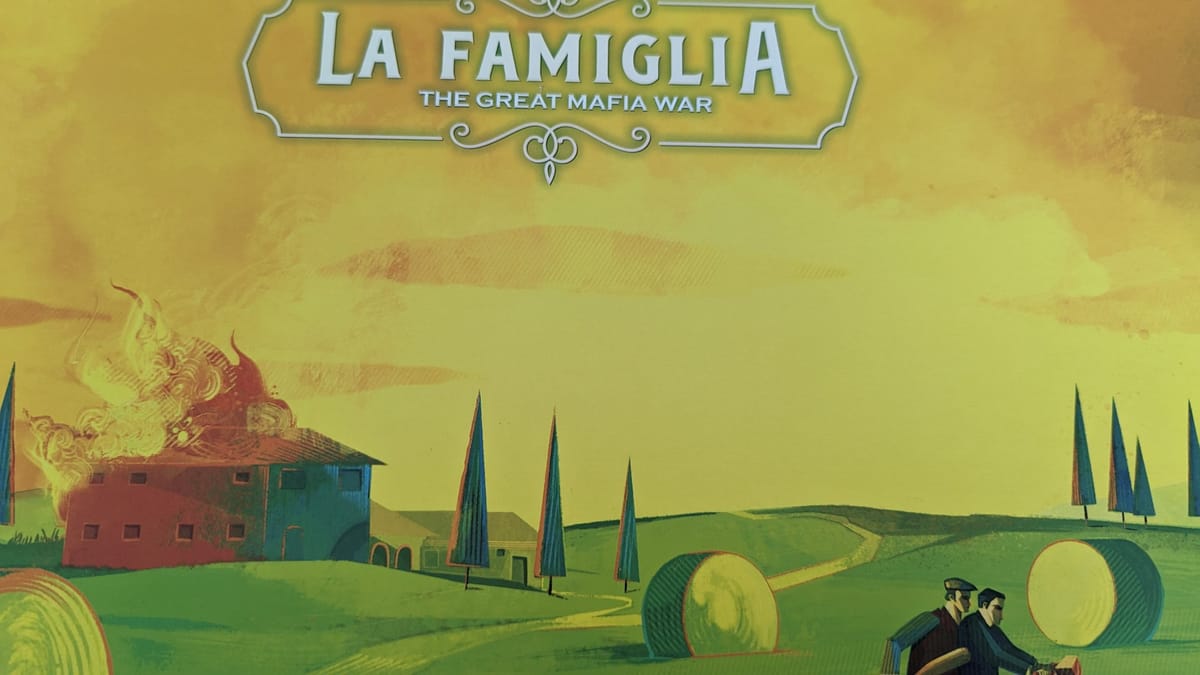
On paper, La Famiglia has all the makings for a home run. Just looking at the companies involved, it’s another Feuerland/ Capstone import, the combo that brought us the obscenely good Ark Nova. Mechanics wise, it’s an asymmetric team-based worker placement and area control hybrid, with hidden order tokens that saw their most notable appearance in the Game of Thrones board game. Layered on top of all of this is gorgeous art by Weberson Santiago. All that was enough to get me hyped for the game, and that excitement sustained through my first few plays. But on our later plays, as we got our heads around how the systems work with each other, we got beat over the head with this game’s harshest failure, which drove the whole experience into the Mediterranean: the combat absolutely sucks.
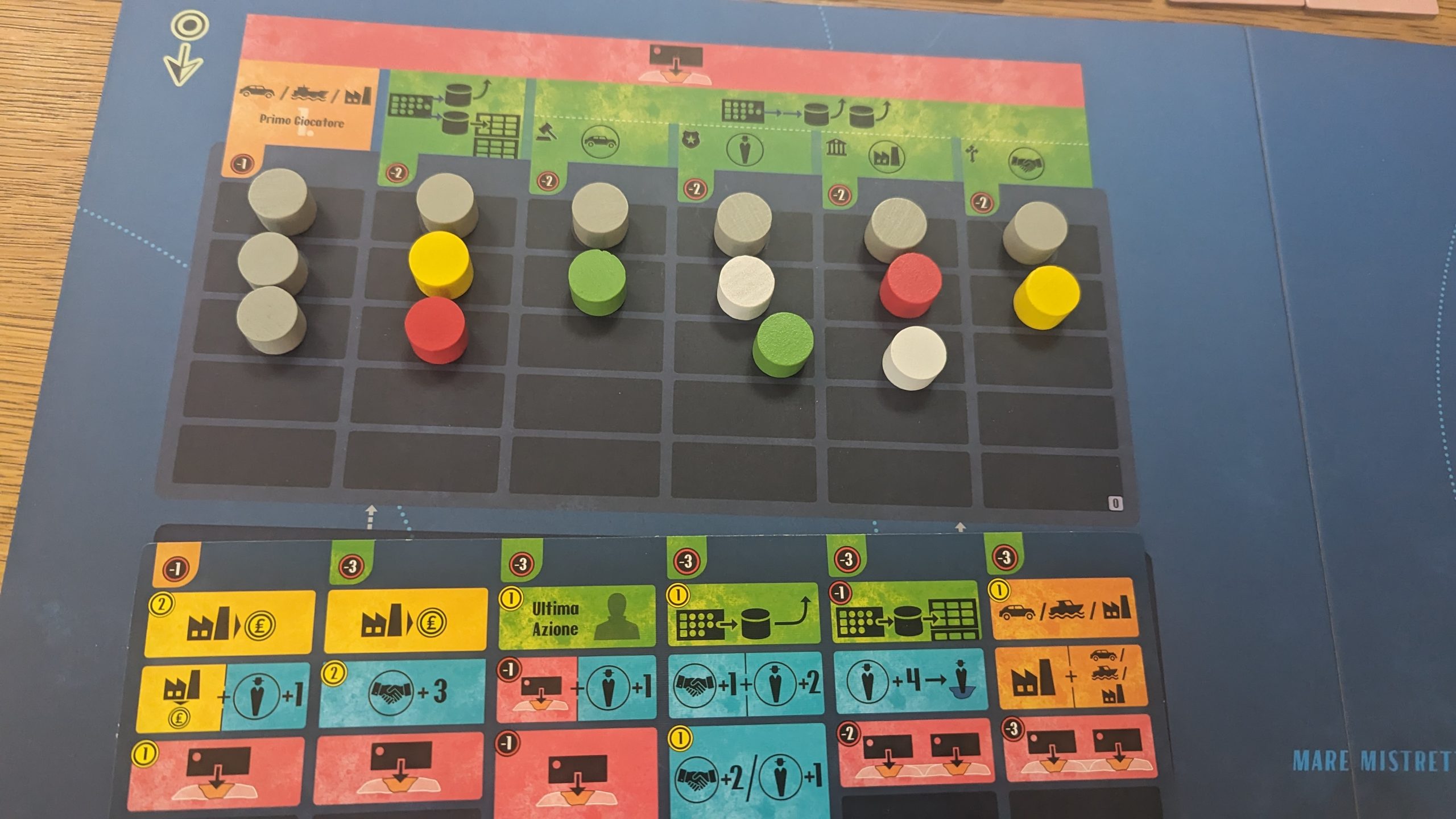
Zooming back out, La Famiglia has two teams of two taking on the roles of competing mafia families during the brutal conflict that engulfed Sicily in the 80’s, with the objective of controlling enough regions to end the game early, or have more than the other team at the end of the game’s fourth and final round. Setup is easily the simplest part of the game- you randomly choose 7 of the game’s 11 region control powers and deal 3 factions to both teams, who secretly assign one to each player, discarding the third. Then players seed the board with faction and neutral boys according to what corner of the board is closest to them and then take turns placing whatever bonus pieces their random setup card provides. Finally, the top action sheet gets set up with neutral and faction action discs, and everyone can get on to actually playing the game. Rounds in La Famiglia consist of two phases, planning and encounter, with a brief upkeep at the end of both.
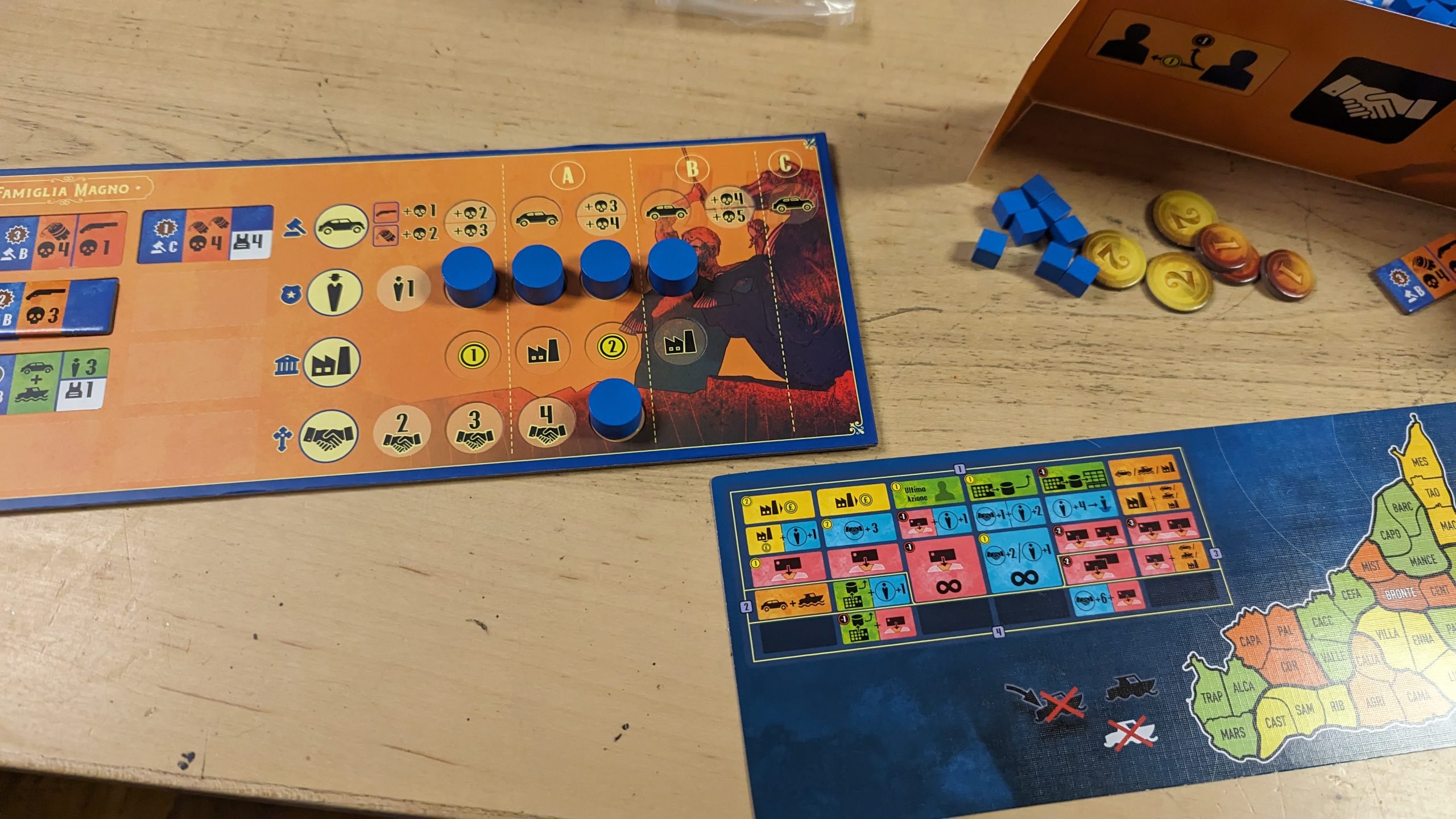
The vast majority of the decision space exists in the planning phase, as that’s when everyone is doing their worker placement actions and distributing orders around their territory. Most of your actions will consist of taking a single disc from the top sheet and placing it on an available space on the bottom to perform the depicted action, paying the owner of the disc a dollar if you moved a disc other than your own. The other, and much more expensive option, is to perform one of the six top column actions. They all have a hefty initial cost, but it quickly skyrockets: for every remaining disc in the column you choose, you have to pay an additional dollar to the bank along with the aforementioned dollar to each other player whose disc you’re moving. For example, if I’m red and I’m wanting to do a top column that has a printed cost of 4 and green and yellow discs, I’m gonna have to dish out 8 dollars, an absolute fortune, even for players that have invested heavily in their economies, but a legitimate impossibility for those that have ignored it. But with great cost comes great effect: column actions universally allow you to drop an order and move all the column’s discs onto unused spaces of your choice on the bottom sheet, allowing you to simultaneously cut down the number of remaining actions that phase and shape the options left. The actions themselves are all strong enough to justify their costs on their own; the leftmost column lets you drop a vehicle or lab onto the board and take the first player token, which everyone who’s played a worker placement game will know is good enough in that phase, but it will also let you resolve your orders in the upcoming encounter phase before your opponents. The other actions consist of removing two tokens from one or two of your family board’s four tracks, strengthening your economy, recruitment, boy placement, or utilization of cars.Passing milestones also unlocks your advanced orders, which can get absurdly strong as the game moves along. As soon as all the discs have been moved to the bottom sheet, there’s a quick management sub-phase, where you check each region and flip existing control tokens or place face down control tokens in regions where a player controls 2 of the 3 areas, or remove existing control tokens if a player no longer controls the requisite 2. Players that flipped a token face up get to place a disc on one of their team’s region control powers, making it available to their faction(but not their teammate), and those that lost control remove one. If one team has control of 6 or a single player has control of 5, that team immediately wins.
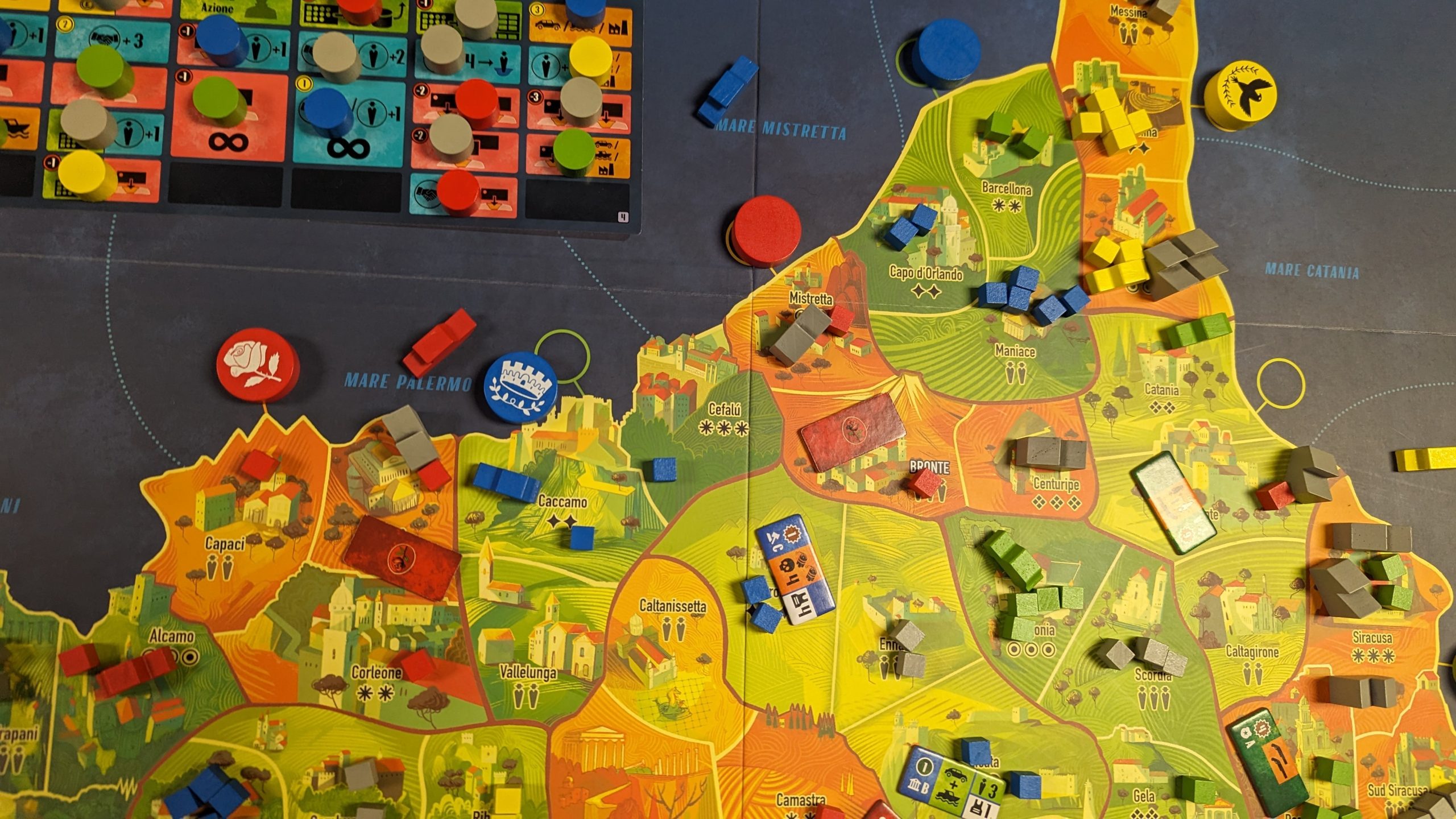
When maintenance is done, we can head on to the Encounter phase, the meat of the area control portion. Everyone flips their orders face-up and starts resolving them in ascending initiative order, completing supply orders before moving to attacks, with initiative ties being resolved in turn order. Supply orders are usually simple area-specific versions of worker placement actions that will additionally bolster your defenses in the area they’re in. Attacks are a bit more complicated, and come in two flavors: bomb and move, sometimes combined. Bombs on their own kill their value’s worth of enemy dudes in an adjacent area, minus whatever defense they may have from labs or orders, but become obscenely deadly when combined with a car. When resolving a bomb, you can spend a colocated car to add your car bomb bonus to the bomb’s value, which can easily wipe out even the most fortified areas. For example, a maxed-out blue player using their double four bomb with two cars is actually doing 9 twice, which is pretty much gonna empty out an area of their choice. Moves are how you actually take areas, and will initiate combat unless resolved against areas that have been emptied. Moves must be done into an adjacent area, unless you have special region ability or are in a coastal region, in which case you can attack any other coast that you have boats to travel through. After resolving any auto kills provided by the order or an accompanying car, the attacker has two options: brute force the attack, taking two automatic casualties and eliminating boys 1:1 until only one side remains, or finesse, a double-bluff minigame. Both players will place one of their three combat cards face-down in front of them, and then they decide to either take their opponent’s card or leave things as-is, starting with the attacker. After both players have made their decision, they resolve the card(s) left in front of them, with the one or two strength coward having you move a guy or two from the conflict into the headquarters(behind their screen), and the turncoat replacing an enemy boy with one of yours. With cards resolved, combat is finished the same way brute force is, nixing a guy from both sides until there’s only one left. As soon as everyone’s resolved all their orders, there’s another maintenance phase just like after planning, with the addition of setting up the next round by moving the bottom action sheet up and replacing it with a new one for the appropriate round.
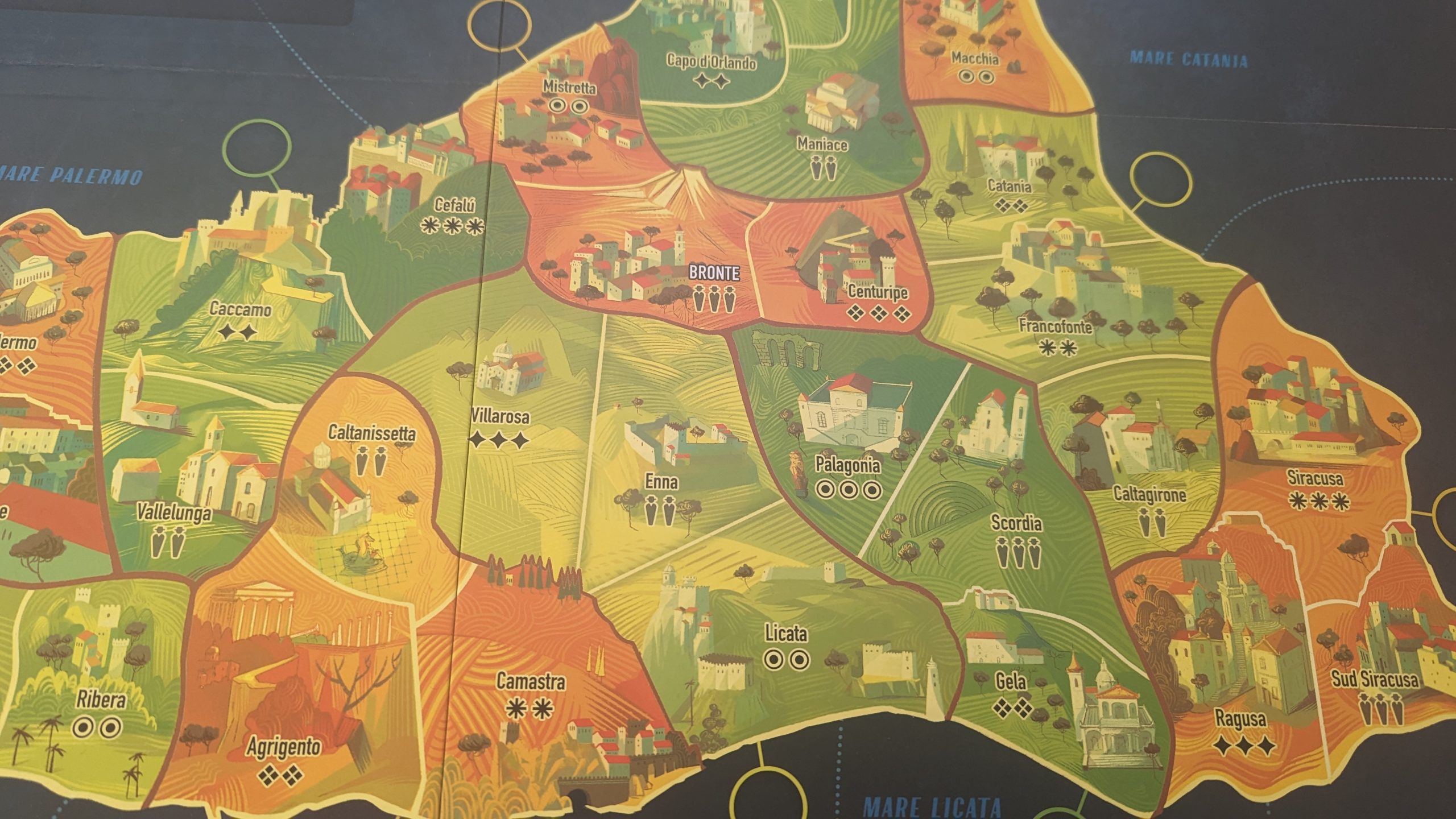
In case you couldn’t tell by how long my simplified teach is, La Famiglia gives all the crunch you’d expect from a big box Capstone release, eased by the team format. I really adore the core mix of worker placement and area control, but the combat system is an unmitigated disaster. The finesse double bluffs feel like fighting a mixup character, only that in a fighting game you have a plethora of exchanges for strategies to evolve, but in La Fam, a couple of bad finesses to open the game can have you losing two 1V4s based upon no information, which puts your team behind the eight ball so bad you may as well reset. In the end, it winds up feeling like a very important part of the game is pure luck, which feels particularly bad and dissonant in a game with this much crunch. Problem is, the combat isn’t the only chink in the armor- there also seems to be some very real balance issues. Upgraded cars are so important in area control that blue, the faction that specializes in them, has won every one of our test games it was in. The problem is exacerbated if the remote detonator region power is available, which lets car bombs affect areas 2 away from the order, meaning a well played blue can wipe any given area clear in the late game. My last gripe, which may sound like a minor annoyance to some, but winds up being the nail in the coffin for me, is the map design. In any given area control game, especially one you’re going to be playing for several hours, it’s of utmost importance that borders are clear and readable at a glance, but there are multiple areas where the art adjacent to the border winds up blurring where everything is.
La Famiglia
Good
I really love La Famiglia in theory; a heavy team based worker placement area control hybrid sounds amazing. But its strict requirements of exactly four players who can handle a game like this, when combined with the amount of times it totally fumbles, leaves me with a game I don't feel comfortable suggesting to anyone who doesn't already know this is exactly what they want.
Pros
- Mixes familiar systems in a unique and brain burning way
- Team play in a long crunchy game lightens the burden on any individual player
- Gorgeous art
Cons
- Some of the systems should've been left on the shelf
- Questionable balance
- The art makes the game less readable instead of more
